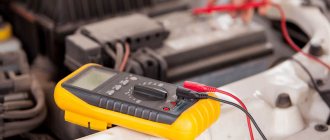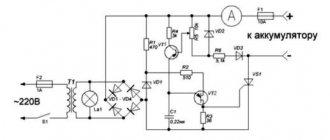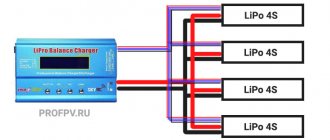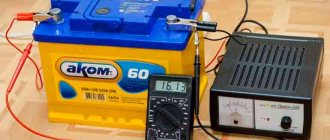Any motorist may find himself in such conditions when the car’s battery suddenly stops working, and there is no way to charge it from a conventional charger. For example, if the car has not been used for a long time and has been parked for several months, the battery will gradually discharge and stop working. In addition, if you leave the headlights on, the battery will run out very quickly overnight, and you simply won’t be able to start the car. In such cases, you should know how to charge the battery without a charger, using methods known to many drivers.
Determining the reason: diagnostics
If the car does not start, you should first find out exactly whether the reason lies in the battery. First you need to pay attention to the dashboard. If the indicators on it light up dimly or don’t light up at all, it means the battery is definitely dead. It’s good to have a voltmeter built into the dashboard: in this case, a sharp drop in voltage readings will indicate a problem with the battery.
It is also necessary to inspect the car battery itself. All modern batteries are equipped with a charging indicator, by the color of which you can tell whether the battery is low or not. When the indicator lights up red, that means it is so.
If the battery is dead, this will also affect the sound of the engine. The sound will be weak, more monotonous and very viscous, with a characteristic clicking sound under the hood. If any of these signs are suddenly detected, you will have to think about how to charge the car if there is no charge, showing a certain amount of ingenuity and sociability.
How to make a homemade charger
Homemade chargers are assembled according to various schemes. The design of one of them provides for the production of a reliable and efficient 14.5 V adapter with a maximum current of 6 A. In addition to it, a DC-DC converter is installed.
To assemble the charger you will need:
- diode bridge;
- cooling radiator;
- alligator clips for connecting the battery;
- step-down transformer with a power of 150 W;
- circuit breakers;
- 220 V plug;
- capacitors;
- ammeter.
When assembling the charger, it is important to take into account the polarity and correct connection of the converter to the negative of the car battery. The diode bridge must also be securely fastened to the radiator. Using this equipment, you can assemble more complex circuits - the main thing is to have the appropriate skills and follow safety precautions.
Homemade charger circuit diagram.
The “lighting” method from another car
One of the good old ways to get your car moving is to try to recharge a dead battery from the battery of another car passing by. Any seasoned motorist will tell you that if a problem arises with how to charge a battery without a charger, this is the most proven and correct way out of the situation. If a problem with the battery occurs while traveling, when it is not possible to get to the nearest technical service center on foot, other motorists will willingly and understandingly come to the rescue.
When working with batteries, keep in mind that there are many different electronic devices inside the hood of modern cars. It is important to get to the batteries without damaging them. Although, in theory, manufacturers take into account the possibility of charging one car from another, and there should be enough space for lighting. It is easy to find two terminals on the battery: positive and negative, and the positive terminal always looks larger.
In order to carry out the process of charging a dead battery from a donor car, you will need two thick wires with strong and wide clamps with a cross-sectional area of at least 10 mm2 each. The wires must be at least 1.5 meters in length and must have a dense rubber braid, otherwise they will not withstand low temperature conditions. It is not recommended to use thinner wires, because if a strong current is applied, they may simply burn out. The current strength set before applying it must be at least 200 A.
It is best to use professional wires with wide clamps and standard colors accepted in electronics: the red wire is the “positive” pole, and the black wire is the “negative” pole. Wide clamps provide the best degree of contact, and the large cross-section of professional wires transmits current most correctly.
This is interesting: Tips for car battery maintenance
Once a driver is found who agrees to help, you can jointly proceed to the following actions:
- First fix the “positive” clamp on the positive terminal of the battery of the car receiving assistance;
- The “positive” clamp should also be fixed to the positive terminal of the battery of the “donor” car.;
- connect the negative wires strictly in the same sequence “receiver - donor”, constantly monitoring the polarity;
- do not allow wires to touch each other;
- start the engine of the donor car for 10-15 minutes;
- Do not disconnect the wires throughout the entire process.;
- start the engine of the receiving car only after 10-15 minutes have elapsed, turning off the “donor” engine first;
- remove the clamps from the terminals without turning off the engine of the receiving car, according to the principle - “minus” from the donor, “minus” from the recipient, “plus” from the donor and “plus” from the recipient;
- let the engine of the receiving machine run for a few more minutes until the process is fully completed.
How to calculate what current will charge the battery when using a lamp and charging from a laptop
A living example from life or how to calculate the current for charging a battery
I had a 110-watt halogen lamp, or at least that’s what it said on its packaging.
I know that the car battery provides 12 volts, and my lamp is 110 watts, so to find out what current the lamp will require from the battery and the generator, you need to divide 110 watts by 12 volts = 110/12 = 9.2 Amperes.
Now we will find out the resistance of the light bulb, or so to speak, how much current we will have left on the wires that will follow the lamp after it lights up.
To do this, we need to divide our 12 volts (voltage in the car network) by the current strength 9.2A that the light bulb consumed = 12/9, and the current strength we found out above is equal to 9.2 Amperes
This means 12/9 = 1.3 Ohm, resistance is measured, and Ohm
Let’s say we found a 19-volt laptop power supply in our stash. We know that the car battery provides 12 Volts, so it needs to be charged with a large number of volts, that is, at least 13, because if there is 12V on the power supply and 12V in the car battery, then the current simply will not flow anywhere, that is, the current that flows in the battery must exceed 12 volts.
We recommend reading: TOP 12 Rating of high pressure washers for cars and homes
So, we know that our charger produces 19V, we allow the battery to consume 13V, in total there will be 19-13 = 6 volts left for our light bulb, because the charger gave out 19, we will allocate 13 to the battery, in total, only 6 volts will remain for the 19 volt lamp . Knowing this data, we can calculate how much current will flow to our battery at a voltage of 13 Volts.
I=U/R, we get = 6 volts/1.3 Ohm = 4.6 Amperes battery charging current, we are completely satisfied with this.
Since the battery charging current is popularly calculated as follows - for example, you have a 60 Ampere battery, to find out with what maximum current it can be charged, you need to divide the Amperes by the number 10 = 60A / 10 = 6 Amperes - this is the maximum permissible charging current for this battery, and we have 4.6 Amperes at the output, which is perfect for our indicator, because we have not exceeded the threshold of 6 Amperes of the permissible current for charging.
Well, if it’s not at all clear how and what to calculate, then I recommend reading this article and also this one. Well, as a quick tip - any laptop charger with a voltage of up to 20 volts and a current of up to 6 Amps is perfect for charging any battery, taking into account the use of any car light bulb.
Car pushing method
An equally old and traditional method of “boosting” the battery, allowing you to start the engine in a short time. However, at the present stage, it is important to consider that it is only suitable for cars equipped with a manual transmission.
The essence of the method: after discharge, a certain amount of energy remains in any battery, which should be enough to start the starter. You can ask people who pass by for help. When the engine starts, you should not turn it off immediately, but drive it on the road for a while in order to maximally “boost” the battery. There are more extreme methods for starting a car if the battery is dead.
How long does it take to charge a car battery using a laptop charger?
Everything is simple here, you need to divide the power of your Battery by the current of the charger and the output number will indicate the time until 100% charging of your battery.
From the example above it turns out that we have a 60 Amp battery, we charge it with a current of 4.6 Amps, which means the charging time for this battery will be 60/4.6 = 13.04, that is, the charging time for this battery if it is discharged to zero will be 13 hours 4 minutes.
We recommend reading: DSG gearbox malfunction problems
How to charge your battery in an emergency
Of course, such methods can help out when the motorist is within the city limits or on a busy highway, where the chances of meeting potential helpers are quite high. But how can you charge the battery if the driver finds himself in some remote place and the battery stops working?
In this case, there are several improvised methods for “reviving” the battery, for example:
- emergency engine start using a regular battery;
- just shake the battery a few times.
Any regular battery can be removed from a flashlight or from a phone. Then open the hood of the car and find the wire that leads from the battery to the generator, which supplies the necessary signal when the ignition key is turned. The wire should be disconnected and a battery should be inserted in its place. Give the car a good push. If possible, it is better to push it down the hill, then jump into it while moving and quickly turn the key. Remove the battery after the engine starts without turning it off. Of course, this method requires a certain speed of reaction, but when there is no other way out, absolutely anything can happen.
If the battery is lead-acid with liquid inside, you can remove it from the hood of the car and gently shake it several times so that the liquid components are evenly distributed throughout its body. Of course, it is important to observe the greatest possible safety precautions.
This is interesting: Causes of oxidation of car battery terminals and ways to restore them
Charging methods at home
Portable storage
You can charge your car battery without a charger using a portable adapter. Most of these devices are sold as launchers that drivers often use on the road. Portable models are equipped with gel and lithium batteries. The device also comes with alligator clips and adapters. Some models have a cigarette lighter connection - this is convenient and safe.
In general, portable chargers are divided into:
Portable jump starter.
- household;
- combined;
- specialized.
The design of modern chargers includes a transformer, an ammeter and even a diode bridge. To protect the device during operation, adjustment elements are provided. Using a portable battery charger, you can charge various types of batteries - the main thing is that the supplied voltage matches the battery parameters. In the instructions for the unit, the manufacturer indicates exactly how the terminals are connected. In this case, it is unlikely that the battery capacity will be completely restored, but the charge will be enough to start the engine. In the future, the battery capacity should be replenished using standard devices.
Charging a laptop
To assemble a charger from an adapter from a laptop or computer, you need a multimeter, a light bulb and cables to connect the circuit elements. The essence of the design is to transfer voltage from the charger to the battery.
Charging from the laptop power supply.
First of all, the positive pole from the internal contact of the adapter from the laptop is connected to the multimeter. It will allow you to track the strength of the charging current that is supplied to the circuit. After this, the “plus” wires are connected to a light bulb with a power of 18-22 W, and then directly to the positive terminal of the battery. The negative pole from the laptop charger is connected directly to the negative terminal of the battery.
A correctly assembled circuit will allow you to quickly recharge the car battery within 30-50 minutes. The resulting capacity is enough for one or two engine starts.
Network 220 V
To restore the capacity of a car battery, you can assemble a simple device operating from a 220 V network. The design includes a capacitor and a powerful semiconductor diode with a voltage of about 1000 V. The capacity can be used non-polar, rated for 400 V or more.
Assembling the circuit involves the following steps:
- one cable from the 220 V network is connected to the capacitor;
- the second terminal of the latter is connected to a diode;
- its cathode is screwed onto the positive terminal of the battery;
- the free contact of the 220 V network is connected to the negative terminal of the battery.
The strength of the charging current is determined depending on the capacity. It is possible to use parallel connection of capacitors to determine the required value, but usually a calculation of 70-100 mA per 1 μF is used.
Incandescent lamp
Another effective way to recharge a dead car battery is to use a 220 V light bulb with a power of 40-100 W. The circuit also requires a semiconductor diode of 3 A or more. A light bulb acts as a regulator of the charging current in this design. The higher its power, the more capacity the battery will receive.
The circuit connection order is as follows:
Charging from an incandescent lamp.
- Connect the cathode of the diode to the positive terminal of the battery. Connect one end of the light bulb to the anode of the semiconductor device.
- Attach the second contact of the light bulb to the plug to connect it to a 220 V power supply.
- Connect the negative terminal of the battery to the other terminal of the plug. If it is not there, then carefully insert the ends of the cables, stripped of insulation, directly into the outlet.
It is recommended to do all manipulations with a soldering iron. When connecting devices to a 220 V network, the operation of the circuit is checked by the glow of the light bulb. If it lights up at full strength, there is no charging current. As soon as the battery starts charging, the glow intensity will be reduced.
Making a homemade charger
If the driver has enough time and appropriate conditions, you can try to make a simple device yourself.
Making a homemade charger will be successful if you have the following components:
- regular light bulb (from 60 to 200 watts);
- semiconductor diode;
- wiring with terminals with plug for socket.
The higher the power rating of the light bulb, the faster the car battery will charge. However, you should not use a light bulb with a power rating greater than 200 watts: not only the semiconductor, but also the battery may burn out. You can touch any element of the circuit being built with unprotected hands only if it is disconnected from the power source. It is important to remember that the circuit will be under very high voltage.
A semiconductor diode is necessary to convert alternating current into direct current during the charging process. When drawing up a circuit, you need to take into account that the diode will take half of the alternating current, so the power of the burning light bulb will be half as much.
The average duration of such charging is about ten hours.
If at the moment there is no time to charge the battery for several hours, but you urgently need to “revive” it, you can use a very simple scheme for making a “fast-revitalizing” charger.
The simplest charging scheme
You can assemble a simple charger yourself without any problems: a transformer (for a 12 V battery it should give more than 11 V), a diode bridge (connect to the secondary winding), a light bulb on one wire between the bridge output and the battery (you can use a light bulb from car headlights for 12 V).
And it is necessary to check the voltage with a voltmeter, when it is close to the maximum, disconnect the charger (it is best to record the measurement results to see how quickly it is rising and whether it can be expected to quickly approach the upper limit). As the final voltage, you can take a value of about 14 V - the battery will not be fully charged, but this should already be enough for installation in the car.
Basics
When powering smartphones, it is recommended to use the “original” wire that came with the kit. If it is damaged or lost, it can be replaced. It is better to purchase a cable that is specifically designed for your gadget.
This does not mean that other means are not available. Any smartphone charger is suitable for replenishing the battery. The main thing is that the plug matches the connector. But third-party wires can damage your phone's battery or shorten its life. Therefore, they cannot be used constantly. This is not a full replacement of the charger, but a temporary solution. As soon as possible, find or buy a special cable that is suitable for the device model.
You can do without charging if you have a MicroUSB-USB adapter and a computer. Just connect your smartphone to your PC. Or purchase an electrical plug with a USB socket. With its help, you will replenish the battery from the outlet, as with a regular charger.
There are also adapters that can be connected to the car's cigarette lighter. This method is suitable for you if you spend a lot of time driving and have nowhere to charge the battery. The smartphone will be powered while the car is running. But fuel consumption will increase slightly. If you turn off the engine and leave the car battery on, the phone will drain it.
A universal option is external batteries. They always come with a suitable cable. Sometimes there are several cables for different types of devices. These products are used at home or taken on the road. Their capacity is greater than that of a telephone battery. That is, they “fit” more energy that you can carry with you.











